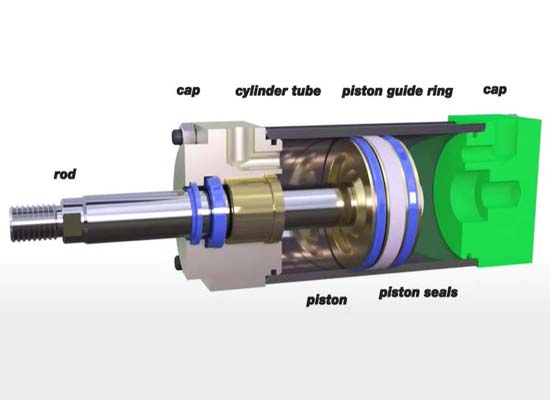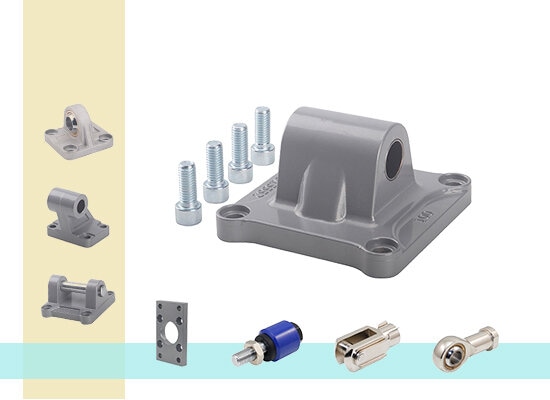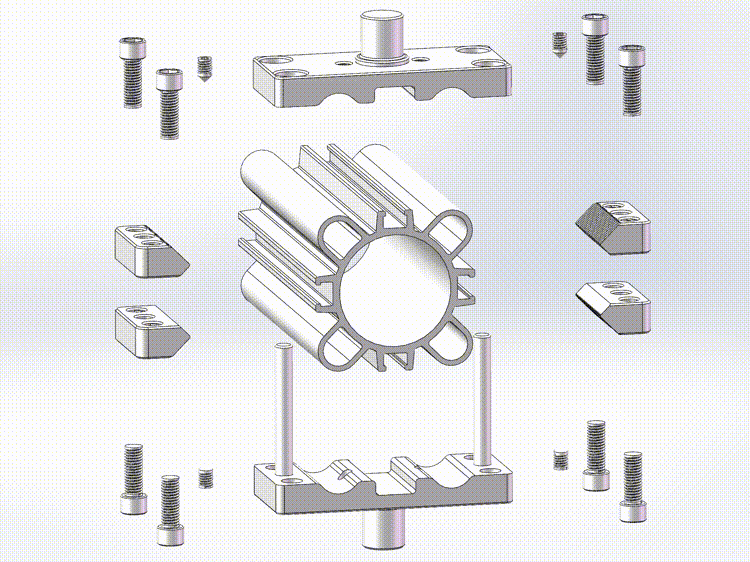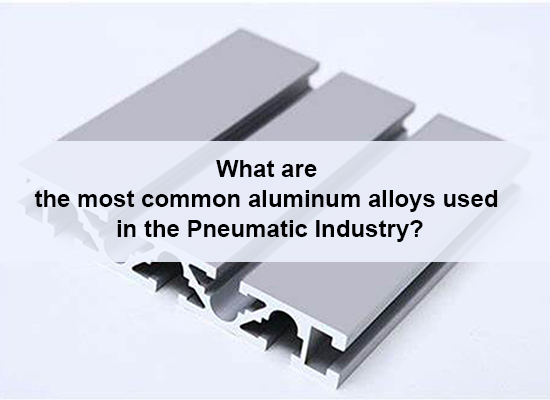Apr 23, 2025
The air cylinder is an actuator in a pneumatic system that converts the compression energy of air into mechanical energy.There are various types of cylinders — including single-acting cylinders, double-acting cylinders, rodless cylinders, pneumatic rotary cylinders, and anti-rotation cylinders — their working characteristics and application ranges differ.
What are the parts of a pneumatic cylinder?However, they are all fundamentally made up of cylinder assembly kits consisting of the cylinder tube, end caps, piston, piston rod, and cylinder cushioning pad.
The cylinder assembly kit consists of multiple parts to constitute the cylinder, It is also a critical component type for the cylinder's operation and functionality
Cylinders parts are various and seem that every type part is indispensable, so which one is the most crucial part? we will focus on studying the various parts of the cylinder assembly kit in thia article.
The cylinder barrel(tube) is typically a containing part and one of the pneumatic cylinder components.As the largest component part, it also determines the cylinder's size.Understanding these influencing factors is crucial for more accurate and efficient use of air cylinder:
| Feature | Description |
|---|---|
| Material | Typically made of durable materials like steel or aluminum,stainless steel. |
| Function | Serves as the outer casing for pistons and provides a surface for piston sealing to maintain pressure and prevent leaks |
| Design | Offers various bore sizes, lengths, and thread types for installation depending on the application |
| Pressure Resistance | Designed to withstand the pressure exerted by fluids within the cylinder |
| Durability | Ensures long-term use even under high-pressure conditions |
| Installation | Typically includes threaded ends or flanges for easy connection to the rest of the system |
In summary, the role of the cylinder barrel(tube) in the cylinder should not be underestimated. These functions include selecting appropriate materials, functions, designs, pressure resistance, durability, and installation, thereby improving the efficiency and durability of pneumatic cylinders used in various industrial processes. Aluminum cylinder tubes made of high-strength aluminum alloy have gradually become a very popular choice.
The importance of guidance and support part---cylinder caps is often underestimated.

Cylinder caps distributed in the front and rear sections of the cylinder barrel,they not only serve a simple sealing function, but also have multiple functions such as guiding piston rod movement, connecting gas sources and control systems, and withstanding working pressure and mechanical loads. They are very important parts. A cylinder is composed of multiple components, among which the caps play a crucial role in its function. Understanding their functions and uses can improve the performance of cylinders and extend their service life.
Introduce
End cap is a part that distributed in behind the cylinder barrel. It has multiple functions, including maintaining the structural strength of equipment and ensuring the normal operation of internal components.
| Function/Role | Description |
|---|---|
| Sealing and Containment | Seals the cylinder, ensuring pressure is maintained inside the barrel and preventing air or liquid leakage. |
| Mounting Point | Provides a secure point for attaching the cylinder to the rest of the mechanical system or equipment. |
| Contamination Prevention | Prevents dirt, dust, or other contaminants from entering the cylinder |
| Supporting Piston and Rod | Helps guide and secure the piston rod, allowing it to move smoothly within the barrel without unnecessary friction or misalignment. |
| Pressure Distribution | Distributes internal pressure evenly within the cylinder |
| Structural Integrity | Designed to withstand mechanical stresses and pressures |
| Allowing Sensor and Port Integration | Some end caps are equipped with sensors, ports, or exhaust devices |
The end cap plays multiple roles in ensuring efficient operation and effective use of the cylinder. Its importance is reflected in various aspects, from providing perfect sealing and structural support to ensuring easy installation and adjustment of airflow. Understanding the different uses of end caps can help develop correct maintenance measures and improve the performance of pneumatic systems. The reliability and efficiency level of the entire pneumatic system in industrial applications are crucial, and Fokca can help you better grasp the design and quality issues of cylinder parts-end caps.
The cylinder converts compressed air into mechanical motion, Piston and piston rod are the main working implementation parts of this mechanism.The following text will provide a detailed introduction to these components and their functions.
| Component | Description | Function |
|---|---|---|
| Piston | A cylindrical disc within the cylinder bore. | Converts the energy of compressed air into linear motion. |
| Piston Rod | A rod connected to the piston and extending outside the cylinder. | Transmits motion from the piston to external mechanisms. |
How It Works
| Component | Working Principle |
|---|---|
| Piston | When compressed air acts on one side of the piston, it generates a force that pushes the piston in the desired direction. |
| Piston Rod | It transmits the motion of the piston to the connected machine or equipment. The piston rod provides the mechanical output of the cylinder and drives external components based on the linear motion of the piston. |
| Interaction | When compressed air enters the cylinder, the piston moves and transmits motion through the piston rod, thereby performing mechanical tasks such as moving a part of the machine. |
| Sealing and Lubrication | Piston seals prevent fluid leakage, and piston rods are typically coated or treated to reduce friction. Seals at both ends ensure that the cylinder remains well-sealed under pressure. |
| Force Distribution | The piston rod must be sufficiently strong to withstand the strong forces generated during operation without bending or deforming. |
| Return Mechanism | The return mechanism enables continuous cyclic operation of the piston and piston rod. |
Conclusion
According to this table, the piston and piston rod mechanism can function within the cylinder and contribute to the movement and performance of pneumatic or hydraulic systems.
Understanding the working principle of the piston and piston rod mechanism is crucial to fully utilize the cylinder. In various industries, if we understand how these components combine to convert compressed air into mechanical force, we can effectively utilize pneumatic systems. Mastering this knowledge can not only improve operational efficiency, but also help maintain and repair such systems, thereby increasing their lifespan and reliability in different industrial environments. The core parts of a cylinder are the piston and piston rod mechanism; Therefore, once the working principle is mastered, there is unlimited room for innovation and improvement in the mechanical engineering process.
The piston buffer mechanism is a crucial part of cylinder design, which slows down the speed of the piston at the end of its stroke to prevent severe impact on mechanical components inside the cylinder, thereby reducing wear and extending the service life of the cylinder.The piston buffer mechanism is a key component to ensure smooth, efficient, and safe operation of the cylinder. It can not only extend the service life of the equipment, but also improve the overall performance of the cylinder. Buffer mechanisms are crucial for various industrial and automation applications due to their advantages of reducing mechanical impact, lowering noise, and improving control accuracy.
In addition to the pneumatic cylinder components mentioned above, there are also cylinder mounting brackets and extended functional parts.
The mounting bracket is a cylindrical metal mounting support that provides the cylinder with the freedom to pivot around an axis, greatly improving its flexibility in application;A magnetic pneumatic cylinder refers to a type of air cylinder equipped with magnetic sensors switch or similar functional extension accessories. It is one of the key accessories that enable automation control in pneumatic systems.
In addition, there are advanced sensors and pull rods for seals and guide rings in cylinder parts.When it comes to durability and reliability, Fescolo air cylinders accessories are unparalleled and an ideal choice for upgrading Industrial automation systems. For nearly forty years, Fescolo have been committed to providing quality and efficient pneumatic cylinder components to ensure any types of air cylinders applicated in any industrieswork smoothly and stably.
You May Interest In

Apr 09, 2025 Blog
What is cushioning in pneumatic cylinder

Mar 10, 2025 Blog
Custom Mounting Bracket for Custom Cylinders
FOKCA ©1998-2025 Fescolo Pneumatic All Rights Reserved Sitemap